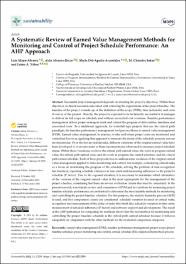Mostrar el registro sencillo del ítem
“A Systematic Review of Earned Value Management Methods for Monitoring and Control of Project Schedule Performance: An AHP Approach “
| dc.contributor.author | Mayo-Alvarez, Luis | es_ES |
| dc.contributor.author | Alvarez-Risco, Aldo | es_ES |
| dc.contributor.author | Del-Aguila-Arcentales, Shyla | es_ES |
| dc.contributor.author | Sekar, M. Chandra | es_ES |
| dc.contributor.author | Yáñez, Jaime A. | es_ES |
| dc.date.accessioned | 2023-02-14T20:56:10Z | |
| dc.date.available | 2023-02-14T20:56:10Z | |
| dc.date.issued | 2022-11-17 | |
| dc.identifier.uri | https://hdl.handle.net/20.500.13053/7793 | |
| dc.description.abstract | “: Successful project management depends on ensuring the project’s objectives. Within these objectives, technical success is associated with achieving the expectations of the project baseline. The baseline of the project is made up of the definition of the scope (WBS), time (schedule) and costs (S curve) of the project. Directly, the project is expected to be technically successful if it manages to deliver its full scope on schedule and without associated cost overruns. Baseline performance management is how project managers track and control the progress of deliverables, timelines and associated costs. In a traditional approach, for waterfall-type projects that use the critical path paradigm, the baseline performance management tool par excellence is earned value management (EVM). Earned value management, in practice, works well when project costs are monitored and controlled; however, applying this approach to measure the status of the schedule presents serious inconsistencies. Over the last several decades, different variations of the original earned value have been developed to overcome some of these inconsistencies when used to measure project schedule status. Within these variations, we have the critical path earned value; the work in progress earned value; the critical path earned value and the work in progress; the earned schedule; and the critical path earned schedule. Each of these proposals tries to address some weakness of the original earned value management applied to time monitoring and control, for example, considering critical tasks as a focus on monitoring the progress of the schedule, solving the problem of task recognition late finishers, reporting schedule variances in time units and measuring adherence to the project’s schedule (P factor). Due to the exposed situation, it is necessary to determine which alternative of the versions of the original earned value is the most appropriate for the management of the project schedule, considering that there are several evaluation criteria that must be considered. In the present research, a systematic review and comparison of EVM and its variations for measuring project baseline schedule performance are performed to determine the most suitable methods for monitoring and controlling the project baseline schedule. For this purpose, the analytic hierarchy process (AHP) is used, and five comparison criteria are considered: schedule variation focused on critical tasks, recognition and measurement of the delay of tasks that finish late, schedule variation in time units, measurement of schedule adherence (P factor) and software support and development. The result of the AHP performed for comparing the methods shows that the best method for monitoring and controlling the project baseline schedule is the critical path earned schedule because it behaves adequately in comparison with the other methods for the evaluated comparison categories.“ | es_ES |
| dc.format | application/pdf | es_ES |
| dc.language.iso | eng | es_ES |
| dc.publisher | MDPI | es_ES |
| dc.rights | info:eu-repo/semantics/openAccess | es_ES |
| dc.rights.uri | https://creativecommons.org/licenses/by/4.0/ | es_ES |
| dc.subject | "earned value management (EVM); baseline performance management; project scope; project baseline schedule; project monitoring and control; earned schedule (ES); analytical hierarchical process" | es_ES |
| dc.title | “A Systematic Review of Earned Value Management Methods for Monitoring and Control of Project Schedule Performance: An AHP Approach “ | es_ES |
| dc.type | info:eu-repo/semantics/article | es_ES |
| dc.identifier.doi | https://doi.org/10.3390/su142215259 | es_ES |
| dc.type.version | info:eu-repo/semantics/publishedVersion | es_ES |
| dc.publisher.country | CH | es_ES |
| dc.subject.ocde | http://purl.org/pe-repo/ocde/ford#3.03.00 | es_ES |
Ficheros en el ítem
Este ítem aparece en la(s) siguiente(s) colección(ones)
-
Web of Science (WOS) [237]


